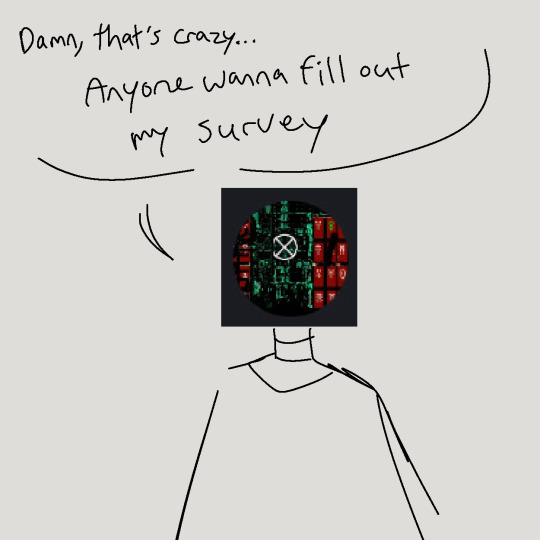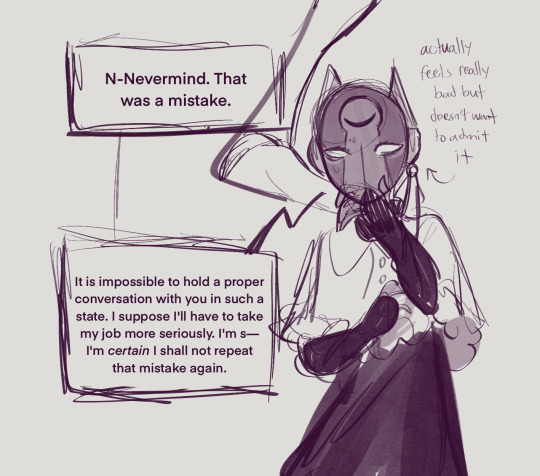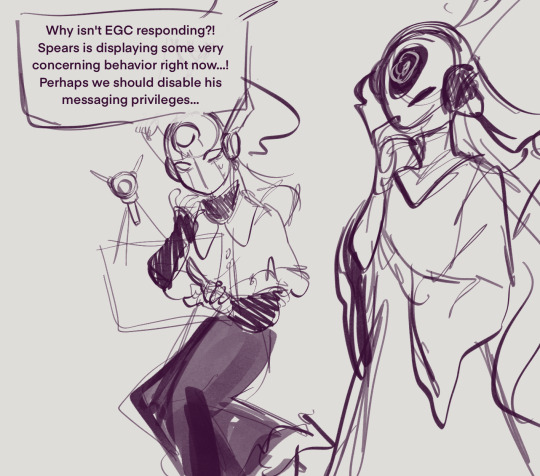#egc
Explore tagged Tumblr posts
Text
related to the previous post


more boxline shenanigans. the spears stuff has basically nothing to do with the mips but it's really funny so im posting it here hashtag YOLO

SSR did not have a design or personality yet but I randomly decided my one anonymous tupper i made to Host the relevant Anonymous Line in that rp woukd be SSR.
his moderation style boiled down to: "please don't send malware aha" and literally nothing else unless it concerned the Mobile Iterator Project. he was so iconic for this. also this was where he became The Survey Guy. which is a gimmick I gotta re-introduce eventually. basically he's very lonely and pathetic and wants to entertain people and drum up engagement (me bleeding in ooc) but also he wants to be mildly helpful by Gathering Information
#the vault#jun 2024#boxline canon#nonmips#legacy of famine#perpetual umbra#egc#tlspts spears#sand smoothed reckoning#mipdoodles#luna's art
2 notes
·
View notes
Text

She's slowly growing back her fur on her chin, and her neck (they shaved her neck shorter for some reason?). Her arms that were shaved are growing back too.
Compare it to when I brought her home from her biopsy (when they shaved her chin) on 24 Jan.
Warning tiny amount of blood and stitching

#Zoe#cat#my pets#Zoe had a biopsy that diagnosed her with eosinophilic granuloma complex#egc#tw: blood#tw: stitches#progress
5 notes
·
View notes
Text
There are no age or gender or species requirements for consideration and acceptance into the new academy/college/university of magics witchcraft arts and sciences of the A•°•A•°•. If you have a desire to learn I have a desire to welcome you, Acolyte.
Please send a brief resumé describing yourself, your talents, interests and prior education.
I will respond to all inquiries.
#ordo templi orientis#Ecclesiastica Gnostica Catholica#egc#A.'.A.'.#black magick#white magic#green magick#wicca#gnosis#chaos#kaos#ars goetia#witchcraft
6 notes
·
View notes
Text

In Memorium, St. + Pan
6 notes
·
View notes
Text
02:59, 01.14.24
i feel as if i am repenting for sins i was not aware i committed.
maybe that’s a lie. but i have yet to be told what my penance is.
maybe it’s crying myself to sleep like i have been the last few nights, listening to the songs we’ve shared for years on repeat, wondering what i did wrong. wondering why you were the one to leave this time.
i don’t think i’ve ever missed you like this, not as a lover, but as my best friend.
i’m so fucking sad all the time, and all i want is my best friend to tell me i’m going to be okay.
you were supposed to take me with you. it was supposed to be you and me running far away and never looking back. you said you wouldn’t go without me.
it’s not too late.
please come back for me.
#eke#egc#honey#actually bipolar#actuallytraumatized#bipolar type 2#spilled ink#excerpt from a letter i'll never send#trauma#frienship#spilled poetry#best friends
3 notes
·
View notes
Text
Legal & HR Considerations for Employee-Generated Content
The enthusiasm around Employee-Generated Content (EGC) as a powerful marketing tool is undeniable. It offers authenticity, expands reach, and builds trust in ways traditional advertising simply can't. However, as companies increasingly encourage employees to become brand advocates, they must navigate a complex web of legal and HR considerations to harness EGC's benefits while mitigating significant risks.
Ignoring these crucial aspects can lead to intellectual property disputes, costly compliance violations, reputational damage, and strained employee relations. Proactive planning and clear policies are not just bureaucratic hurdles; they are essential safeguards for a successful and sustainable EGC program.
Here are five key legal and HR considerations for companies embracing Employee-Generated Content:
1. Intellectual Property (IP) Ownership and Usage Rights
One of the most fundamental questions to address is: who owns the content created by employees? While an employer generally owns work created by an employee within the scope of their employment (work-for-hire doctrine in many jurisdictions), EGC often blurs these lines. What if an employee creates a video on their personal phone, using their own time, but it promotes the company's product?
Clear IP Assignment: Companies need clear policies or agreements stating that any content created by employees that benefits the company (even if outside normal working hours or on personal devices) automatically becomes the company's property or that the company has perpetual, royalty-free rights to use, modify, and repurpose it across all channels.
Usage Scope: Define explicitly how the company intends to use the EGC (e.g., on its website, social media, in ads, internal communications). This transparency manages employee expectations.
Existing Agreements: Ensure that general employment agreements or IP policies cover EGC, or create a specific addendum for employee creator programs.
Without clarity, companies risk disputes over content ownership, usage, and even demands for compensation after the fact.
2. Confidentiality and Proprietary Information
Employees, by nature of their roles, have access to confidential and proprietary company information – unreleased products, internal strategies, financial data, client lists, and more. EGC poses a significant risk of inadvertent or intentional disclosure.
Explicit Guidelines: Social media policies must clearly define what constitutes confidential information and explicitly prohibit its sharing on public platforms.
Pre-Approval Processes: For highly sensitive industries or content, consider a light-touch pre-approval process for EGC, especially if it touches on product roadmaps, internal data, or competitive strategies.
Training and Reminders: Regularly educate employees on confidentiality obligations, emphasizing the long-term repercussions of breaches. Remind them that their general non-disclosure agreements (NDAs) extend to online content.
Industry-Specific Regulations: For sectors like healthcare or finance, strict data privacy laws (e.g., GDPR, HIPAA, India's DPDP Act) make accidental disclosures particularly risky, requiring extra vigilance.
A single leak can cause immense financial and reputational damage.
3. Compliance with Advertising Regulations & Disclosures
When EGC functions as marketing or an endorsement, it falls under advertising regulations. Regulators like the Federal Trade Commission (FTC) in the U.S. (and similar bodies globally) require transparent disclosure of material connections between endorsers and brands.
Mandatory Disclosure: Employees acting as brand advocates must clearly disclose their employment relationship in their posts. Simple hashtags like #Employee or #CompanyXYZEmployee or a clear statement in their bio are essential. This is crucial even if they are not directly compensated for the specific post.
Authenticity Requirement: Content must reflect the employee's honest opinions and experiences. The company cannot dictate what an employee must say, only provide guidelines for what they can share.
Consequences of Non-Compliance: Companies can face significant fines and reputational damage if their employee advocates fail to comply with disclosure requirements. Training and ongoing reminders are vital.
The blurred line between personal opinion and company endorsement necessitates strict adherence to these rules.
4. Employee Conduct, Brand Reputation, and Social Media Policies
EGC inherently links an employee's personal online presence to the company's brand image. This necessitates comprehensive social media policies that guide employee conduct both on and off company-owned channels.
Define Acceptable Behavior: Clearly outline expectations for professionalism, respect, and adherence to company values when posting online, even on personal accounts, if it could reasonably be associated with the employer.
Prohibit Harmful Content: Explicitly ban posts that are discriminatory, harassing, defamatory, or hateful. This protects colleagues, customers, and the brand.
Crisis Management: Have a clear protocol for addressing negative or controversial EGC, including how to engage with the employee privately, potential content removal, and crisis communication strategies.
Balance Freedom vs. Control: Policies should aim to empower employees while safeguarding the brand, avoiding overly restrictive language that stifles genuine expression. Employees often have legal protections (e.g., under labor laws for discussing working conditions) that broad policies cannot infringe upon.
A robust social media policy acts as a shield, protecting the company's reputation from unforeseen online missteps.
5. Compensation, Fair Labor Standards & Legal Agreements
If a company chooses to compensate employee creators (beyond their regular salary), it opens up additional legal and HR considerations.
Fair Labor Standards Act (FLSA) / Wage & Hour Laws: For non-exempt (hourly) employees, any time spent creating content for the company's benefit, even outside normal working hours, could be considered "hours worked" and be subject to minimum wage and overtime pay requirements. This is a significant risk if not managed properly.
Classification: Be cautious not to accidentally classify employees as independent contractors for EGC purposes if they are otherwise employees, as this can lead to misclassification penalties.
Creator Agreements: Formalize the compensation model (e.g., per post, performance bonus, non-monetary incentives) through a written agreement. This agreement should also cover IP, usage rights, and disclosure requirements, separate from or as an addendum to the main employment contract.
Tax Implications: Clearly outline the tax implications of any compensation provided to employee creators.
Careful structuring of compensation ensures compliance with labor laws and clear understanding of financial arrangements.
In conclusion, Employee-Generated Content offers unparalleled marketing advantages, but its successful integration requires a proactive, strategic approach to legal and HR considerations. By developing comprehensive social media policies, securing clear IP rights, ensuring regulatory compliance, educating employees, and carefully structuring any compensation, companies can build a robust employee advocacy program that leverages their most authentic voices while effectively mitigating the inherent risks. It's about empowering employees safely and strategically, ensuring that their valuable contributions benefit both the brand and themselves, without stepping into legal pitfalls.
To learn more, visit HR Tech Pub.
0 notes
Text

Spider-Man #1 (Gold Edition) è una variante speciale del fumetto Spider-Man #1 del 1990, scritto e disegnato da Todd McFarlane.
• Questo numero segna il debutto della serie autonoma di Spider-Man, separata da The Amazing Spider-Man.
• Todd McFarlane, già famoso per il suo lavoro su The Amazing Spider-Man, ottenne il controllo creativo completo su questa serie, sia come scrittore che come disegnatore.
• Il numero vendette oltre 2,5 milioni di copie, diventando uno dei fumetti più venduti di sempre.
• La Gold Edition è una delle edizioni variant più rare e ricercate.
• A differenza della versione standard (con copertina argentata), questa ha dettagli in oro sulla copertina.
• In origine, venne distribuita in quantità limitata, spesso a rivenditori o per scopi promozionali.
• Il fumetto inizia con Spider-Man che affronta Lizard (Curt Connors) in una battaglia cupa e viscerale.
• McFarlane enfatizza un tono più oscuro e psicologico, sia nella narrazione che nei disegni dettagliati.
• Il focus è sul conflitto interiore di Peter Parker e sulla brutalità degli scontri.
1 note
·
View note
Text
I can't with my self
I love how the reason I introduced myself in ESC by being chased by a bug is because in real time there was a bug in my house and I didn't wanna kill it so I sat outside.... I mean.... very funny introduction but, like also a little confusing.. anyways have a nice day!
-AstoriaAura or Prof. Aura
0 notes
Text
AUTOJUSTO
// Descripción: Automotora compra y venta de autos usados. Parte del Holding Grupo-o2
Manejo de RRSS
Creación de Contenido
EGC (Contenido generado por Empleados)
Producción y Postproducción de videos
instagram


Instagram.com/autojusto_cl
Autojusto.cl
0 notes
Text
When Work Becomes Content: The Exploitation of Employee Voices in the Age of EGC
Let’s be honest: we’re living in a time when the lines between work and life are blurrier than ever. Between Slack notifications at dinner and emails marked “urgent” on Sunday mornings, the boundaries of what it means to “show up” for your job have shifted. And now, we’ve added a new twist to the story: Employee-Generated Content (EGC). On the surface, EGC looks like a win-win. Companies get…
0 notes
Link
New listing on Coinstore Coin: EGC Market pairs: EGC-USDT
#newcoinlisting#crypto#cryptonews#cryptoAlerts#altcoins#bitcoin#blockchain#cryptocurrency#cryptotrading#BTC#EGC#Coinstore#USDT
0 notes
Text

This scenario is from boxline canon and I found it funny so I'm posting it. It's a hypothetical scenario I drew because Umbra thought "well if I was watching Spears I'd do a better job". unfortunately this is not the case. idk how to explain what happened to spears um basically he attacked someone and so he got put in time out (iterator grafted onto him to administrate him) instead of being executed,
also boxline Umbra was such a hater oh my god. They wanted TLSPTS GONE. being fair he did hurt their friend (SLS) and torture her friend and attacked her other friend so I get it









for context TLSPTS is very Normal about Citizens and MIPs exist in a strange grey area as pseudo-bennies. or pseudo-archies as per terminology of MIP AU . psuedo-anchovies . sorry i mean like pseudo-people yknow bc minds of architects bla bla bla. free citizens (not really)
anyways PU was sent home after a long lecture about Clouds and Weather.
TLSPTS belongs to prismsoup and EGC (guardian) and Watcher in the Dark (magic 8ball forehead) belomg to my friend Ark
#the vault#jun 2024#boxline canon#nonmips#perpetual umbra#EGC#tlspts spears#watcher in the dark#luna's art#mipdoodles#stupid images#mip units
1 note
·
View note
Text
Zoe has done 14 days of 1 tablet of 5mg Prednicare and 0.2mls of Cyclavance.
Now she can have 14 days of 1/2 tablet of 5mg Prednicare and 0.2mls of Cyclavance.
After that, it's 1 tablet of 1mg Prednicare for 14 days and then 1 tablet of 1mg Prednicare every other day till gone (roughly 14 tablets).
But sadly needs 0.2ml of Cyclavance for 6 months total.
But she's getting there. Next stage of Prednicare at least.
Her new hypoallergenic Hills Z/D pate and dry food diet is doing her well. Her stool looks good, compared to semi loose before. Hopefully, it prevents more allergies in the future. She likes it too.
Can't wait till she's eosinophilic granuloma complex free.
0 notes
Text

In Memorium, St. + Algernon Charles Swinburn.
2 notes
·
View notes
Text
What are Emerging Growth Companies and how is the cap on their annual gross revenue indexed to inflation?
Emerging Growth Companies (EGCs) are a new category of issuers created by the Jumpstart Our Business Startups (JOBS) Act.
To name a few exemptions EGCs are permitted:
to include less extensive narrative disclosure than required of other reporting companies, particularly in executive compensation
to provide audited financial statements for two fiscal years. Other reporting companies are required to provide audited financial statements for three fiscal years
not to provide an auditor attestation of internal control over financial reporting under Sarbanes-Oxley Act Section 404(b)
to defer complying with certain changes in accounting standards
One of the requirements for a company to continue as an EGC for the first five fiscal years after it completes an IPO is if it has "total annual gross revenues" of less than $1.235 billion during its most recently completed fiscal year. “Total annual gross revenues” means total revenues as presented on the statement of comprehensive income under U.S. GAAP (or IFRS as issued by the IASB, if used as the basis of reporting by a foreign private issuer).
The JOBS Act requires the SEC to make inflation adjustments every five years to the annual gross revenue amount used to determine EGC status, to reflect the changes in the Consumer Price Index for All Urban Consumers (“CPI-U”) published by the Bureau of Labor Statistics (“BLS”). The adjusted gross revenue threshold must be set to the nearest $1,000,000 during its most recently completed fiscal year. In 2017, the Commission increased the annual gross revenue amount from $1,000,000,000 to $1,070,000,000. On September 9, 2022, the SEC adopted amendments to Securities Act Rule 405 and Exchange Act Rule 12b-2 to reflect another inflation-adjusted annual gross revenue threshold from $1,070,000,000 to $1,235,000,000.
The new EGC gross revenue threshold amendments are determined by:
1. Determine the appropriate CPI-U for December of the calendar year preceding the year of adjustment
Example - When making the inflation adjustment for the EGC revenue threshold in 2022, use the CPI-U for December 2021, which was 278.802. Then use the CPI-U for December of 2011, the calendar year before the EGC definition was established by the JOBS Act, which was 225.672 (“2011 CPI-U”)
2. Calculate the cost-of-living adjustment or inflation factor - Divide the 2021 CPI-U ( 278.802) by the 2011 CPI-U ( 225.672) which will result in the inflation factor of 1.23543.
3. Calculate the inflation adjustment, multiply the initial EGC gross revenue threshold, $1,000,000,000, by the inflation factor 1.23543, the product of which would be $1,235,430,000.
The increase in EGC gross revenue threshold from the initial threshold of $1 billion would be $235,430,000 rounded to $235,000,000 under the statutory rounding convention.
4. Add the rounded increase of $235,000,000 to the initial EGC revenue threshold of $1,000,000,000 which yields an inflation adjusted EGC revenue threshold of $1.235billion
The above methodology is consistent with the methodology the Commission used in 2017 when the first increase to reflect an inflation-adjusted annual gross revenue threshold was administered.
Sources :
Final Rules Inflation Adjustments under Titles I and III of the JOBS Act
INFLATION ADJUSTMENTS AND OTHER TECHNICAL AMENDMENTS UNDER Titles I and III of the JOBS Act
SEC Adopts JOBS Act Inflation Adjustments
Emerging Growth Companies
About The Author
Arushi Bhandari is an MBA and a licensed CPA in the state of California. She has helped several companies at different stages with their accounting and tax related issues. Her publications eBooks - STARTUP Financing, Equity and Tax and Introduction to Equity Compensation are available on Apple iBookstore, Amazon Kindle and Google Play. She maintains a public blog at www.startuptaxaccounting.com and has guest blogged at different startup platforms such as The Startup Garage and Belmont Acquisitions.
DISCLAIMER: The information provided is intended to educate the readers and a more definite answer should be based on a consultation with a lawyer or CPA.It should not be relied upon as legal advice because the information might be incomplete and answers could change depending upon circumstances and if all facts were known.
0 notes
